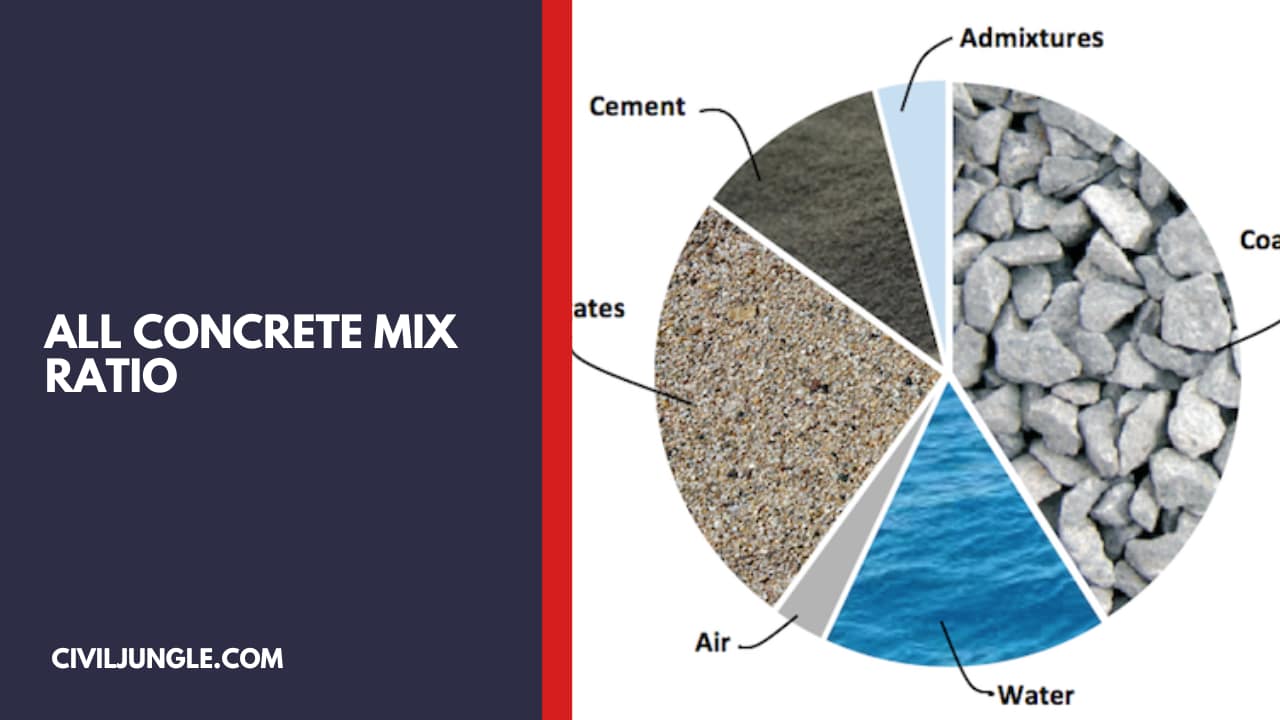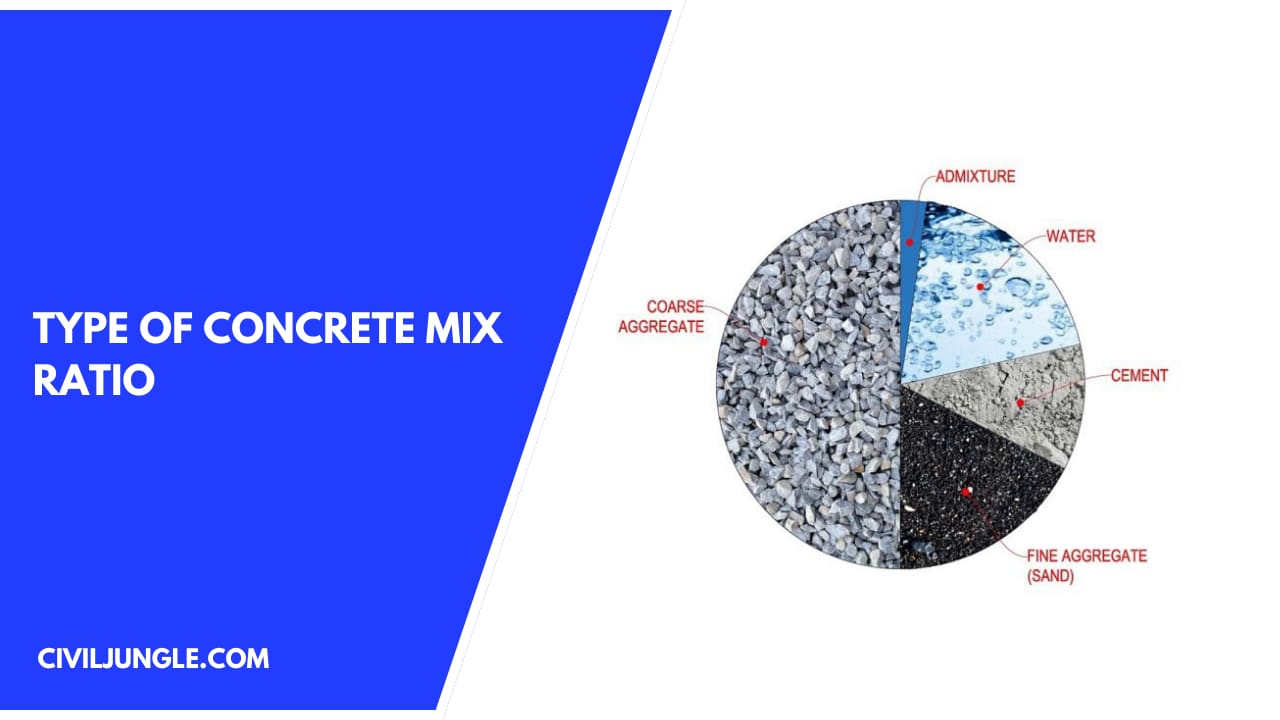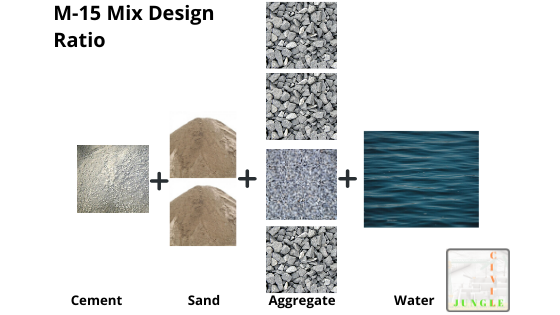What Is Concrete Mix Ratio?
Important Point
Making concrete, it is important to use the correct concrete mixing ratios to produce a tough, long life, durable concrete mix.
To make concrete, four basic materials you need: Cement, sand, aggregate, water, and add-mixture.
This concrete mix ratio of aggregate to sand to cement is an important factor in determining the compressive strength of the concrete mixture.
This concrete mixture ratio of 1 part cement, 1 parts sand, and 3 parts aggregate will produce a concrete mix of approximately 2500 to 3000 psi. Mixing water with this cement, sand, and aggregate will form a paste that will bind the materials together until the mix hardens.
This strength properties of the concrete are inversely proportional to the water-cement ratio. Basically, the means the more water you use to mix this concrete, the weaker the concrete mix.
This less water you use to mix the concrete, the stronger the concrete mix. Accurate concrete mixing ratios may be achieved by measuring this dry material using buckets or some other kind of measuring device.
By measuring the mixing ratios, you will have a consistent concrete mix throughout your entire project. Relevant Is Code: Is 456-2000 for Concrete mix ratio table
Also, read: Methods of Design | Difference Between Working Stress Method and Limit State Method
Type of Concrete Mix Ratio.
As Per IS Code 456-2000 three different part of Concrete Mix Ratio
- Nominal Concrete Mix Ratios.
- Standard Mixes Ratio.
- High Strength Concrete Mix Ratio.
1. Nominal Concrete Mix Ratios
The specifications for concrete prescribed these proportions of cement, sand, aggregates, and water. These mixes of the fixed cement, sand, and aggregate ratio that ensures adequate strength are termed nominal mixes.
Nominal concrete mixes offer simplicity and under normal circumstances, have a margin of strength above that specified. However, because of the variability of mix ingredients, the nominal concrete for given workability varies widely in strength.
This nominal mix ratio is generally adopted for small scale constructions. In this types of mix, this nominal concrete mix ratios and concrete constituent proportions are prefixed and specified.
2. Concrete Mix Formula Example
M 15 mixing concrete ratio of Concrete (1:2:4) here (1 no of Cement quantity, 2 nos of Send quantity, 4 nos of Aggregate quantity, Here quantity measured by mixing box) it also called recipes for concrete
E.g., M15(1:2:4), the quantity of cement, sand (fine aggregate), and coarse aggregate are batched in volume as per the fixed ratio 1:2:4. From the above table till M25 grade, these concrete proportions are called as Nominal mix concrete.
Different Types of Grade for Concrete Ratios as below.
| Concrete Grade | Mix Ratio< | Compressive Strength | |
| MPa (N/mm2) | psi | ||
| Normal Grade of Concrete | |||
| M5 | 1 : 5 : 10 | 5 MPa | 725 psi |
| M7.5 | 1 : 4 : 8 | 7.5 MPa | 1087 psi |
| M10 | 1 : 3 : 6 | 10 MPa | 1450 psi |
| M15 | 1 : 2 : 4 | 15 MPa | 2175 psi |
| M20 | 1 : 1.5 : 3 | 20 MPa | 2900 psi |
Concrete Mix Ratio Table For Nominal Concrete Mix Ratios
Also, read: What Is Guniting, Set Guniting Systems , Advantage, Disadvantage
3. Standard Concrete Mixes Ratio
Standard Mixes Ratio specifications for concrete prescribed these proportions of cement, sand, aggregates, and water. Standard mixes of the fixed cement, sand, and aggregate ratio, which ensures adequate strength, are termed nominal mixes.
Standard mixes offer simplicity and under normal circumstances, have a margin of strength above that specified. However, because of the variability of mix ingredients, the nominal concrete for given workability varies widely in strength.
This Standard mix rati0 is generally adopted for small scale constructions. In this type of mix, this nominal concrete mix ratios and concrete constituent proportions are prefixed and specified.
Standard concrete mixes ratio M30 to M45 grade concrete mix ratio is manual designed. E.g., M45, the quantity of cement, sand (fine aggregate), and coarse aggregate are batched in volume as per the design mix. From the above table till M45 grade, these concrete proportions are called as Nominal mix concrete.
| Concrete Grade | Mix Ratio | Compressive Strength | |
| MPa (N/mm2) | psi | ||
| Standard Grade of Concrete | |||
| M25 | 1: 1: 2 | 25 MPa | 3625 psi |
| M30 | Design Mix | 30 MPa | 4350 psi |
| M35 | Design Mix | 35 MPa | 5075 psi |
| M40 | Design Mix | 40 MPa | 5800 psi |
| M45 | Design Mix | 45 MPa | 6525 psi |
Concrete Mix Ratio Table For Standard Concrete Mix Ratios
Also, read: What Is Cover in Concrete | Clear Cover in Beams, Slab, Column, Footing
4. High Strength Concrete Mix Ratio
High Strength Mixes Ratio specifications for concrete prescribed these proportions of cement, sand, aggregates, and water. High Strength mixes of the fixed cement, sand, and aggregate ratio, which ensures adequate strength, are termed nominal mixes.
High Strength mixes offer simplicity and under normal circumstances, have a margin of strength above that specified. However, because of the variability of mix ingredients, the nominal concrete for given workability varies widely in strength.
This High Strength mix ratio is generally adopted for small-scale constructions. In this type of mix, this nominal concrete mix ratios and concrete constituent proportions are prefixed and specified.
High Strength concrete mixes ratio M50 to M70 grade concrete mix ratio is manually designed. E.g., M70, the quantity of cement, sand (fine aggregate), and coarse aggregate are batched in volume as per the design mix.
| Concrete Grade | Mix Ratio | Compressive Strength | |
| MPa (N/mm2) | psi | ||
| High Strength Concrete Grades | |||
| M50 | Design Mix | 50 MPa | 7250 psi |
| M55 | Design Mix | 55 MPa | 7975 psi |
| M60 | Design Mix | 60 MPa | 8700 psi |
| M65 | Design Mix | 65 MPa | 9425 psi |
| M70 | Design Mix | 70 MPa | 10150 psi |
Concrete Mix Ratio Table For High Strength Concrete Mix Ratios
Also, read: Difference Between Short Column and Long Column | What Is Column | Types of Column
Concrete Design Mix Ratio Basic Info.
The design mixing ration of concrete because of suitable parts of ingredients of concrete determining the relevant amount of objective for producing a concrete of the required strength, workability and durability as economically possible is now as termed this mix design of concrete.
The difference in the cost of materials arises from the fact that the cement is several times costly than this aggregate; thus, the aim is to produce as lean a mix as possible.
Technical point of view, the rich mixes can lead to cracking and high shrinkage at the structural concrete and to the evolution of high heat of hydration in mass concrete, which may cause cracking.
The cost of concrete is related to this cost of materials required for producing a minimum mean strength called characteristic strength of specified by the designer of the structure.
This depends on the QC (Quality Control) measures, but there isn’t doubt that the QC (Quality Control) adds to the cost of concrete.
The extent of QC (Quality Control) is often an economic compromise and depends on the type and size job. The cost of labor depends on the workability of mix design for concrete, e.g., the concrete mix design of inadequate workability may result in a high cost of labor to obtain a degree of compaction with available equipment.
Concrete Mix
A concrete mix is a combination of five major elements in various proportions: cement, water, coarse aggregates, fine aggregates (i.e. sand), and air. Additional elements such as pozzolanic materials and chemical admixtures can also be incorporated into the mix to give it certain desirable properties.
Concrete Mix Ratio
The safest bet for any concrete mix is four-two-one: four parts crushed rock; two parts sand; and one part cement. The four-two-one mix, obviously, has seven parts. Conveniently, when mixing concrete, the ratio can be mixed on any range of scales.
Cement Mixture Ratios
The safest bet for any concrete mix is four-two-one: four parts crushed rock; two parts sand; and one part cement. The four-two-one mix, obviously, has seven parts. Conveniently, when mixing concrete, the ratio can be mixed on any range of scales.
Concrete Mixture Formula
A properly designed mixture possesses the desired workability for the fresh concrete and the required durability and strength for the hardened concrete. Typically, a mix is about 10 to 15 percent cement, 60 to 75 percent aggregate, and 15 to 20 percent water.
Concrete Mix Ratio
The safest bet for any concrete mix is four-two-one: four parts crushed rock; two parts sand; and one part cement. The four-two-one mix, obviously, has seven parts. Conveniently, when mixing concrete, the ratio can be mixed on any range of scales.
Cement Mix Ratios
A properly designed mixture possesses the desired workability for the fresh concrete and the required durability and strength for the hardened concrete. Typically, a mix is about 10 to 15 percent cement, 60 to 75 percent aggregate and 15 to 20 percent water.
Cement Mixture Formula
The safest bet for any concrete mix is four-two-one: four parts crushed rock; two parts sand; and one part cement. The four-two-one mix, obviously, has seven parts. Conveniently, when mixing concrete, the ratio can be mixed on any range of scales.
Concrete Mix Ratios Table
| Concrete Grade | Mix Ratio | Compressive Strength | |
| MPa (N/mm2) | psi | ||
| Normal Grade of Concrete | |||
| M5 | 1 : 5 : 10 | 5 MPa | 725 psi |
| M7.5 | 1 : 4 : 8 | 7.5 MPa | 1087 psi |
| M10 | 1 : 3 : 6 | 10 MPa | 1450 psi |
| M15 | 1 : 2 : 4 | 15 MPa | 2175 psi |
| M20 | 1 : 1.5 : 3 | 20 MPa | 2900 psi |
| Standard Grade of Concrete | |||
| M25 | 1 : 1 : 2 | 25 MPa | 3625 psi |
| M30 | Design Mix | 30 MPa | 4350 psi |
| M35 | Design Mix | 35 MPa | 5075 psi |
| M40 | Design Mix | 40 MPa | 5800 psi |
| M45 | Design Mix | 45 MPa | 6525 psi |
| High Strength Concrete Grades | |||
| M50 | Design Mix | 50 MPa | 7250 psi |
| M55 | Design Mix | 55 MPa | 7975 psi |
| M60 | Design Mix | 60 MPa | 8700 psi |
| M65 | Design Mix | 65 MPa | 9425 psi |
| M70 | Design Mix | 70 MPa | 10150 psi |
How to Mix Concrete Ratio?
The safest bet for any concrete mix is four-two-one: four parts crushed rock; two parts sand; and one part cement. The four-two-one mix, obviously, has seven parts. Conveniently, when mixing concrete, the ratio can be mixed on any range of scales.
Concrete Mix Formula
The safest bet for any concrete mix is four-two-one: four parts crushed rock; two parts sand; and one part cement. The four-two-one mix, obviously, has seven parts. Conveniently, when mixing concrete, the ratio can be mixed on any range of scales.
Concrete Mix Ratio for Foundation
For foundations, a mix of 1 part cement to 3 parts sand to 6 parts aggregates can be used. Measure around half of the cement, sand and aggregates (for a concrete mix only) you’re going to mix. Using half now will prevent the mix from drying out before you get chance to use all of it – you can mix the other half later.
Strong Concrete Mix Ratio
In making concrete strong, these ingredients should usually be mixed in a ratio of 1:2:3:0.5 to achieve maximum strength. That is 1 part cement, 2 parts sand, 3 parts gravel, and 0.5 part water.
Concrete Ratio
Concrete ratio refers to the proportion of different materials that are used to make concrete. It is usually expressed in terms of the amount of cement, sand, and aggregates used in making the concrete mix. The ratio is important because it determines the strength, workability, and durability of the concrete.
Cement Ratio
As per the experts, the safest cement mix ratio for all kinds of concrete used in different construction purposes is 4:2:1. It means 4 parts of crushed stones mixed with 2 parts of sand and 1 part of cement will create the ideal cement mix to prepare concrete for all purposes.
Ratio of Concrete
The standard mix ratio for concrete is 1:2:3. This means that for every part of cement used, two parts of sand and three parts of aggregate are added. This ratio is commonly used in most construction projects, including foundations, walls, and floors.
Concrete Mixture Ratio
This mixture ratio is 1:2:3, which means one part cement, two parts sand, and three parts aggregates (usually gravel or crushed stone). This is the most commonly used mixture ratio and is suitable for most construction projects, including foundations, walls, and floors.
Concrete Mix Ratio for Slab
A concrete mix of 1 part cement : 2 parts sand : 4 parts coarse aggregate should be used for a concrete slab. Concrete must be placed within half an hour of mixing. Place your concrete into your formwork; work the concrete into awkward places and corners using a shovel or trowel.
Cement Concrete Ratio
This ratio is 1:1.5:3, which means one part cement, 1.5 parts sand, and three parts aggregates. This ratio is used for structural applications where higher strength is required, such as in reinforced concrete beams and columns.
Concrete Mix Design Ratio
Concrete mix design ratio is a process of determining the proportions of different materials such as cement, water, aggregates, and admixtures, to achieve the desired strength, workability, and durability of the concrete for a specific application. The concrete mix design ratio depends on several factors, including the type of application, exposure conditions, and desired strength.
Mix Proportion of Concrete
The mix proportion of concrete refers to the ratio or proportion of the primary materials used to make the concrete mixture. These primary materials are cement, sand, and aggregates. The mix proportion of concrete varies depending on the specific application and desired characteristics of the concrete.
Slab Concrete Ratio
The ratio for a slab concrete mix depends on various factors such as the type of slab, the load it is expected to bear, and the environmental conditions. However, a commonly used ratio for slab concrete is 1:2:4, which means one part cement, two parts sand, and four parts aggregates (usually gravel or crushed stone).
Concrete Proportion
Concrete proportion refers to the ratio or proportion of the primary materials used to make concrete, which are cement, water, sand, and aggregates (such as gravel or crushed stone). The proportion of each material used in concrete depends on the specific application and the desired characteristics of the finished product.
Cement Ratio in Concrete
The most commonly used cement ratio in concrete is 1:2:3, which means one part cement, two parts sand, and three parts aggregates (usually gravel or crushed stone). This ratio is suitable for most construction applications, including foundations, walls, and floors.
Cement Mixing Ratio
This mixing ratio is 1:4:8, which means one part cement, four parts sand, and eight parts aggregates. This mix ratio is used for non-structural applications, such as in the construction of footpaths and driveways.
Strongest Concrete Mix Ratio
1:2:3:0.5
Concrete is made from cement, sand, gravel and water.
In making concrete strong, these ingredients should usually be mixed in a ratio of 1:2:3:0.5 to achieve maximum strength. That is 1 part cement, 2 parts sand, 3 parts gravel, and 0.5 part water.
Like this post? Share it with your friends!
Suggested Read –
- Rate Analysis of Concrete
- Procedure for Rcc Concrete
- What is Plum Concrete | Application | Mix Design | Methodology
- What Is Honeycomb In Concrete | Cause | Cure | Types of Grouting
- What Is Workability of Concrete | Factors Affecting Workability | Test |Errors
- Concreting in Construction | Classification | Properties | Grades | Advantage & Disadvantage | Quality Control
Originally posted 2023-05-10 10:30:06.






if you can put approx mix ratio for all parts from M5 to M70 that would be fine.
Well Explained! Will share this article with my colleagues.
Thanks Sir